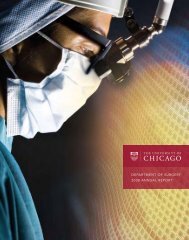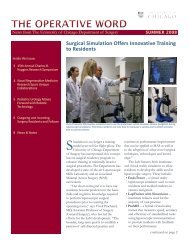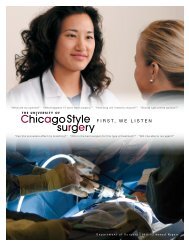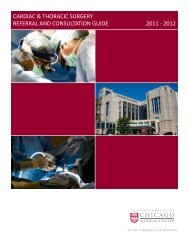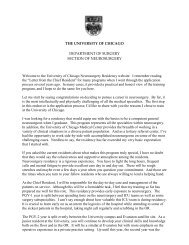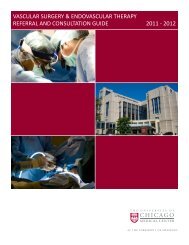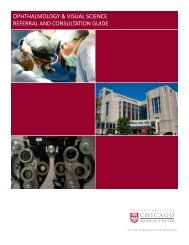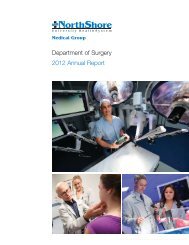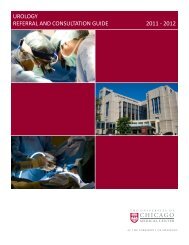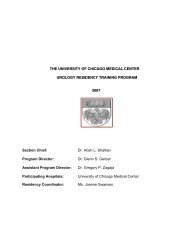Trauma Surgery & Critical Care
Trauma Surgery & Critical Care
Trauma Surgery & Critical Care
You also want an ePaper? Increase the reach of your titles
YUMPU automatically turns print PDFs into web optimized ePapers that Google loves.
Cook County <strong>Trauma</strong>Goals and ObjectivesYear 2To expose the junior surgical resident to trauma surgery and critical care. This willallow our residents to develop knowledge and skills in assessment and treatment ofthe trauma patient, postoperative care, and critical care.A. Medical KnowledgeGoal: The junior surgery resident will achieve a basic knowledge of the evaluation and treatment of avariety of trauma patients. The resident will be exposed to trauma patients and will become comfortablewith the initial evaluation and stabilization of patients.Objectives:1. Understand the application of the American College of Surgeons ATLS guidelines toinclude the primary and secondary survey, utilization of monitoring devices, and the useof invasive and noninvasive diagnostic testing in the resuscitation of the trauma patient.2. Basic knowledge of the evaluation, resuscitation, and treatment of blunt and penetratinginjuries to the following organs or organ systems or body compartments including role ofoperative and nonoperative therapies.a. Airway managementi. Endotracheal and nasotracheal intubationii. Role of cricothyroidotomyiii. Tracheal and laryngeal injuryb. Central nervous system and Spinei. Cervical, thoracic, lumbar spine injuryii. Neurogenic shockiii. Intracranial injuryiv. Methods to minimize secondary injuryc. Face and Necki. Facial and skull fracturesii. Orbital injury and ophthalmologic emergenciesiii. Carotid or vertebral injuryiv. Esophageal injuryd. Thoraxi. Pulmonary injuryii. Chest wall injuryiii. Diaphragm injurye. Mediastinumi. Cardiac injury including contusionii. Aortic injuryiii. Esophageal injuryiv. Tracheal injuryf. Abdomeni. Solid organ injury including liver, spleen, and kidneyii. Hollow-viscus injury including stomach and intestineiii. Retroperitoneum, pancreas, bladder, and major vesselsg. Pelvis
i. Fractures and damage control measuresii. Genitourinary injuryiii. Retroperitoneal injuryiv. Vascular injuryv. Gastrointestinal injuryh. Vasculari. Major vessel injury of extremities, trunk, and visceralii. Extremity compartment syndromeiii. Hard and soft signs of vascular injuryi. Orthopedic and soft tissue injuryi. Fracture management (open and closed) and dislocationsii. Complex wound closureiii. Peripheral nerve injuryiv. Burns3. Learn to appropriately recognize the signs and symptoms of common post-operativecomplications and complications of the trauma patient:a. Chest painb. Sinus tachycardiac. Respiratory failured. Pneumothorax and hemothoraxe. Pulmonary embolism and fat embolismf. Transfusion reaction and sequelae of massive transfusiong. Alcohol withdrawal and delirium tremensh. Low urine outputi. Hemorrhagic shockj. Neurogenic shockk. Wound infectionl. Compartment syndrome of the extremity and abdomenm. Management of complex wounds of abdomen and soft tissuen. Support of patient with entero-atmospheric fistulae4. Learn basics of ventilatory managementa. Modes of ventilationb. Oxygenation techniquesc. Ventilation techniquesd. Weaning strategiese. Physiology of oxygen deliveryB. Patient <strong>Care</strong>Goal: The junior resident will provide patient care that is compassionate, appropriate, and effective for thetreatment of trauma problems.Objectives1. Perform a complete primary and secondary survey of the trauma patient following ATLSguidelines.2. Resuscitate the trauma patient after blunt or penetrating injury, including institutingmedical stabilization procedures such as intravenous fluid resuscitation, invasive lines,chest tubes, intubation, and fracture reduction and immobilization. Begin to establishresuscitative, diagnostic, and treatment priorities in the patient with multiple lifethreateninginjuries.3. Interpret plain X-rays, CT scans, and angiograms.
4. Develop proficiency in the following procedures:a. Arterial catheterb. Central venous accessc. Changing lines over wire (Seldinger technique)d. Chest thoracostomy tubee. Needle thoracostomyf. Intubationg. Diagnostic peritoneal lavageh. Pericardiocentesisi. Cardiopulmonary resuscitation5. Manage the critical care of the trauma patient including:a. Ventilator managementb. Fluid and electrolyte managementc. Massive transfusion and sequelaed. Nutritional maintenance and supplementatione. DVT prophylaxisf. <strong>Trauma</strong>tic brain injury managementg. Ventilator associated pneumonia, catheter associated blood infection, and sepsistreatment, wound infectionh. Sedation and pain management and weaningi. Vasoactive drugsj. Hypothermia6. Participate in the pre- and post-operative surgical management of patients before andafter trauma operations including:a. Preoperative assessment and documentation of consent and preoperative noteb. Post-operative complications7. Participate in and begin to develop competency in the essential trauma and trauma-relatedoperations or procedures including:a. <strong>Trauma</strong> laparotomyb. <strong>Trauma</strong> thoracostomy including sternotomyc. Neck and extremity explorationd. Resuscitative thoracotomye. Emergent cricothyroidotomyf. Tracheostomyg. Percutaneous and open enteral feeding accessh. Complex abdominal wound closurei. Esophagogastroduodenoscopyj. Bronchoscopyk. Proctoscopy8. Perform daily duties for patient care including review vitals signs and 24-hour events,physical examination of the patient, write a daily progress, and present the patient ontrauma rounds each day. The junior resident should carry out all patient related careduties, procedures, orders and documentation.9. Participate in discharge planning for the trauma patient utilizing a multidisciplinaryapproach. Organizing follow-up with consultant services and for follow-up diagnosticstudies. Work closely with social work regarding appropriate placement of and servicesfor the discharged patient.10. When on call as the “back room” resident, the junior resident is the primary physiciancaring for all in-patients on the trauma service, including those patients in the ICU,
<strong>Trauma</strong> Observation and on the wards. He/she will be responsible for all patient care ofthese patients including serially monitoring all ICU patients, ensuring that the daily planfor each patient is carried out, and responding to all acute issues for each patient. Thesenior resident is a resource for the junior resident.C. Practice Based Learning and ImprovementGoal: The junior resident will investigate and evaluate his or her own patient care practices, appraise andassimilate scientific evidence, and improve patient care practices.Objectives1. Utilize information technology to evaluate and treat patients.2. Improve the efficiency of care by appropriate and timely triage of patient-relatedproblems.3. Organize patient data/health information to facilitate timely care and reduce errors.4. Teach medical students and other healthcare professionals about the practices of trauma.5. Achieve functional independence with graduated advancement and responsibilities.6. Learn how and where to acquire relevant patient-care related information (electronicsearches, textbooks, library resources).D. Interpersonal and Communication SkillsGoal: The junior resident will demonstrate interpersonal and communication skills that result in effectiveinformation exchange and teaming with patients, their families, and professional associates.Objectives1. Become an effective listener to the patients and their families.2. Demonstrates compassion for patients and families undergoing surgery and intensive careunit stays.3. Educate patients and their families about postoperative recovery and disposition.4. Communicate patient-related issues in a timely manner to supervising resident orattending physician. Discuss assessments and plans to all consultant services in aprofessional manner.6. Clearly and legibly document progress notes, procedure notes, event notes, and consultforms in the medical record.7. Ensure proper communication of patient-related issues and plans to the nursing staff andother healthcare workers.8. Participate in efficient and comprehensive daily sign-in/sign-outs with the relevantservices.
E. System Based PracticeGoal: The junior resident will demonstrate an awareness of and responsiveness to the larger context andsystem of health care and the ability to effectively call on system resources to provide care that is ofoptimal value.Objectives1. Coordinate the pre- and postoperative care and rehabilitation of trauma patients.2. Use cost-effective and efficient diagnostic testing for patient work-ups.3. Become advocates for your trauma patients within the health care system.4. Refer trauma patients to the appropriate practitioners and agencies.5. Facilitate the timely discharge and/or placement of trauma patients.6. Learn to coordinate the admission of patients and communicate withprimary care physicians, inpatient house staff, and consultants.4. Review and complete the required medical documentation for all admitted/pre-admittedpatients on the morning of their operation.5. Review the relevant standards for quality and safety on the UCMC website.http://intranet.uchicago.edu/quality/F. ProfessionalismGoal: The junior resident will demonstrate a commitment to carrying out professional responsibilities,adherence to ethical principles, and sensitivity to a diverse patient population.Objectives1. Safeguard the welfare of all patients.3. Abide by established ethical and moral principles.4. Respect all patients, their families, all healthcare personnel, and support services.5. Provide timely and efficient care to all patients and requesting services.7. Demonstrate an unbiased sensitivity to our patient’s cultural, spiritual, and personalbeliefs.8. Become accountable for your personal actions and conduct within the medical center.9. Understands the concepts of autonomy, beneficence, nonmaleficence, justice, and respectfor life.10. Dress in a professional manner while caring for patients.11. Maintain patient confidentiality at all times.
Year 4The senior surgical resident will learn and implement the principles of traumasurgery and critical care. This will allow our residents to develop knowledge andskills in assessment and treatment of the trauma patient, postoperative care, andcritical care.A. Medical KnowledgeGoal: The senior surgery resident will achieve a detailed knowledge of the evaluation and treatment of avariety of trauma patients. The resident will be exposed to trauma patients and will become comfortablewith the initial evaluation and stabilization of patients. The resident will formulate treatment approachesfor trauma patients including those with multi-system trauma.Objectives:1. Understand the application of the American College of Surgeons ATLS guidelines toinclude the primary and secondary survey, utilization of monitoring devices, and the useof invasive and noninvasive diagnostic testing in the resuscitation of the trauma patient.5. Knowledge of the evaluation, resuscitation, and treatment of blunt and penetratinginjuries to the following organs or organ systems or body compartments including role ofoperative and nonoperative therapies.a. Airway managementi. Endotracheal and nasotracheal intubationii. Role of cricothyroidotomyiii. Tracheal and laryngeal injuryb. Central nervous system and Spinei. Cervical, thoracic, lumbar spine injuryii. Neurogenic shockiii. Intracranial injuryiv. Methods to minimize secondary injuryc. Face and Necki. Facial and skull fracturesii. Orbital injury and ophthalmologic emergenciesiii. Carotid or vertebral injuryiv. Esophageal injuryd. Thoraxi. Pulmonary injuryii. Chest wall injuryiii. Diaphragm injurye. Mediastinumi. Cardiac injury including contusionii. Aortic injuryiii. Esophageal injuryiv. Tracheal injuryf. Abdomeni. Solid organ injury including liver, spleen, and kidneyii. Hollow-viscus injury including stomach and intestineiii. Retroperitoneum, pancreas, bladder, and major vesselsg. Pelvisi. Fractures and damage control measuresii. Genitourinary injuryiii. Retroperitoneal injury
iv. Vascular injuryv. Gastrointestinal injuryh. Vasculari. Major vessel injury of extremities, trunk, and visceralii. Extremity compartment syndromeiii. Hard and soft signs of vascular injuryi. Orthopedic and soft tissue injuryi. Fracture management (open and closed) and dislocationsii. Complex wound closureiii. Peripheral nerve injuryiv. Burns6. Recognize the signs and symptoms of common post-operative complications andcomplications of the trauma patient and treat the complication:a. Chest painb. Sinus tachycardiac. Respiratory failured. Pneumothorax and hemothoraxe. Pulmonary embolism and fat embolismf. Transfusion reaction and sequelae of massive transfusiong. Alcohol withdrawal and delirium tremensh. Low urine outputi. Hemorrhagic shockj. Neurogenic shockk. Wound infectionl. Compartment syndrome of the extremity and abdomenm. Management of complex wounds of abdomen and soft tissuen. Support of patient with entero-atmospheric fistulae7. Understand and teach ventilatory management:a. Modes of ventilationb. Oxygenation techniquesc. Ventilation techniquesd. Weaning strategiese. Physiology of oxygen deliveryB. Patient <strong>Care</strong>Goal: The senior resident will provide patient care that is compassionate, appropriate, and effective for thetreatment of trauma problems.Objectives11. Perform a complete primary and secondary survey of the trauma patient following ATLSguidelines. Maintain an active role in teaching the survey of the trauma patient to juniorresidents and medical students.12. Resuscitate the trauma patient after blunt or penetrating injury, including institutingmedical stabilization procedures such as intravenous fluid resuscitation, invasive lines,chest tubes, intubation, and fracture reduction and immobilization. Establishresuscitative, diagnostic, and treatment priorities in the patient with multiple lifethreateninginjuries.13. Interpret plain X-rays, CT scans, and angiograms and understand the capabilities andlimitations of each study.
E. System Based PracticeGoal: The senior resident will demonstrate an awareness of and responsiveness to the larger context andsystem of health care and the ability to effectively call on system resources to provide care that is ofoptimal value.Objectives1. Coordinate the pre- and postoperative care and rehabilitation of trauma patients.2. Use cost-effective and efficient diagnostic testing for patient work-ups.3. Become advocates for your trauma patients within the health care system.4. Refer trauma patients to the appropriate practitioners and agencies.5. Facilitate the timely discharge and/or placement of trauma patients.6. Learn to coordinate the admission of patients and communicate withprimary care physicians, inpatient house staff, and consultants.6. Review and complete the required medical documentation for all admitted/pre-admittedpatients on the morning of their operation.7. Review the relevant standards for quality and safety on the UCMC website.http://intranet.uchicago.edu/quality/F. ProfessionalismGoal: The senior resident will demonstrate a commitment to carrying out professional responsibilities,adherence to ethical principles, and sensitivity to a diverse patient population.Objectives1. Safeguard the welfare of all patients.3. Abide by established ethical and moral principles.4. Respect all patients, their families, all healthcare personnel, and support services.5. Provide timely and efficient care to all patients and requesting services.7. Demonstrate an unbiased sensitivity to our patient’s cultural, spiritual, and personalbeliefs.8. Become accountable for your personal actions and conduct within the medical center.9. Understands the concepts of autonomy, beneficence, nonmaleficence, justice, and respectfor life.10. Dress in a professional manner while caring for patients.12. Maintain patient confidentiality at all times.



